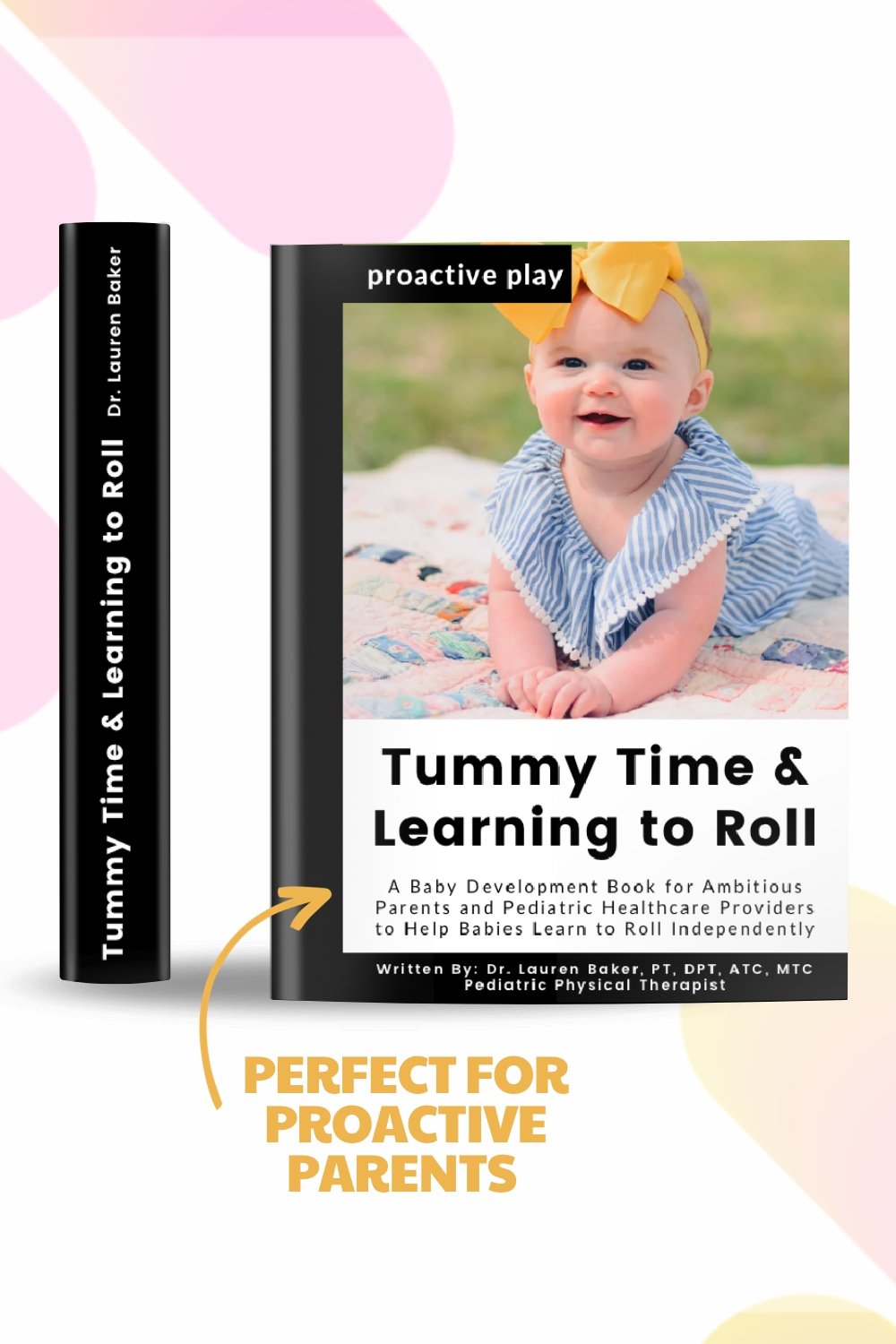Download The Free Learning to Roll Checklist
Perfect for parents trying to uncover what might be blocking their child from rolling back to belly, belly to back, or both on their own.
Easy Exercises to Help Your Baby Roll Over Back to Belly
this blog contains affiliate links
Today, we’re going over how to help our adorable little ones master the art of rolling over from their back to their belly. Back to belly rolling occurs between 4-6 months, but often if a little is struggling or not showing signs of rolling on their own at 5 months, that is a great time to start strategic proactive play.
Rolling is a milestone that sets the stage for many future achievements, and I'm here, your pediatric physical therapy bestie to guide you through it with ease and confidence.
Understanding Rolling Back to Belly
First off, it's crucial to know when to expect your baby to start rolling from back to belly. Typically, this developmental milestone happens between 4 to 6 months.
But if your baby is around 6 months and hasn't mastered rolling yet, don't fret! I've got some easy exercises for you to try out. If you notice significant improvements quickly, you're on the right track.
Otherwise, reaching out to a pediatric physical therapist after the 6-month mark is a wise move, especially since mastering rolling is pivotal for crawling on hands and knees – a key milestone linked to future academic skills like reading and writing.
Back to belly rolling involves a lot of factors including mobility, strength, and coordination. Rolling is one of the first milestones other than eating, where a baby has to coordinate their muscles by turning different groups on and off, which can sometimes be a little more difficult than they thought.
Gravity is also really tough for babies, because it’s always throwing them to the floor. When babies go to roll from their back to their bellies, they have to have enough strength to counteract gravity pushing their arms back toward the floor.
Sometimes, this is a lot to ask of babies and they end up looking less interested in rolling and happy on their backs, while this isn’t a problem necessarily, we want to make sure that it isn’t because something is holding them back from rolling.
There is a difference between not being able to roll and being able to roll easily but just not doing all day every single day. Most babies if given the choice, would definitely pick rolling because their little bodies were made to move.
Why Some Babies Struggle with Rolling
Several factors can contribute to delays in rolling over, including:
Limited Arm Mobility: For a baby to roll over smoothly, they need to be able to move their arms above their head and across their body past the midline (an imaginary line that goes from the top of the head down the middle of the body through the belly button).
Any tightness in the chest or neck could hinder this movement.
Coordination Challenges: Bringing both arms together in one direction requires high levels of coordination. Some babies might find this tricky and require some help to master it.
Restricted Trunk Mobility: A baby needs to rotate their upper body in one direction while keeping the lower half stable. Tightness or inability to do so can make rolling over challenging.
Helping Your Baby Roll Back to Belly: Exercise Breakdown
To bridge the gap between not rolling and rolling over back to belly easily, let's break down the movements into manageable parts.
This approach, known as partial tasking, allows babies to focus on mastering one component at a time. Here's a simple exercise to get started. Make sure to watch the video linked below for an example with a baby and for the most comprehensive information on this technique.
Exercise #1: Reaching to the Right
Positioning: Lay your baby on their back.
Engagement: Hold a toy towards their opposite shoulder to encourage them to reach across with their left arm.
Support: Gently guide their shoulder and arm across the body towards the right.
Follow Through: Once their arm is across, assist their hips to follow, rolling them onto their belly.
Repeat: Try different toys to maintain their interest and repeat the movement, ensuring both arms get a chance to lead.
Exercise #2: Reaching to the Left
Switch Sides: Now focus on using the right arm to reach.
Guidance and Support: This side might be more challenging, so offer more support and use tactile cues to encourage movement if needed.
Hip Assistance: Once their arm is in position, gently guide their hips to complete the roll.
Troubleshooting: If an arm gets stuck, apply gentle pressure to the pelvis and help free the arm to ensure a smooth roll.
Exercise #3: Reaching When on Their Side
If reaching across the body while the baby is lying on their back it too difficult or they struggle with staying engaged (a sign that it could take more effort than they have to give) –
Start with the baby lying on their side and practice reaching and playing with toys with the hand at shoulder level, once this is easy, move the toy above shoulder level and have the baby practice reaching there. Do this on both sides so babies get practice using both arms, once this is easy, move back to exercises 1 and 2.
Resources for Further Learning
For those eager to dive deeper and tackle rolling from every angle, my book "Tummy Time and Learning to Roll" is your go-to resource. It's packed with insights, exercises, and a free video course to visually guide you through each step.
Grab your copy [linked in the video description, pinned comment, and here] and discover how to support your baby's journey towards rolling and beyond.
Screening for Trunk Rotation
A vital part of ensuring smooth rolling transitions is checking your baby's trunk rotation. This movement is crucial for rolling efficiently. Don't miss my next video, where I'll show you how to assess if your baby's trunk rotation is on track.
remember: watch the video below for the most comprehensive guide to this technique and to watch it be done on a real life baby :)
TIMESTAMPS:
2:00 the missing link to rolling back to belly
5:15 how this exercise helps babies learn to roll from back to belly
5:50 the best resource for parents to help babies learn to roll on their own
6:58 exercise #1: reaching to the right
9:07 exercise #2: reaching to the left
TOY IDEAS:
Baby Einstein Music Toy
Crinkle Toys: Bee | Dino | Deer | Sloth | Octopus | Racoon
Best Toys for Babies Learning to Roll
Best Toys for Babies
PT Approved Equipment/Containers for Babies
Tummy Time Toys
Curious About Learning More on Tummy Time, Rolling, or Both?
The absolute best book for parents on tummy time and rolling is: Tummy Time and Learning to Roll: A Baby Development Book for Ambitious Parents and Pediatric Healthcare Providers to Help Babies Learn to Roll Independently. The book comes with a free online video course to help parents fully understand how to complete the different exercises, printable checklists to know exactly where your baby is at, and when to reach out for additional help.
This book was written by Dr. Lauren Baker, PT, DPT, ATC, MTC, who is a Pediatric Physical Therapist in Boise, Idaho, trained in helping parents learn how to help their babies move and master their milestones. She loves teaching parents how to see how their babies are moving as well as how to influence those movements though play positions and exercises to help babies move with confidence and ease.
Tummy Time and Learning to Roll is the first book in the Proactive Play series written by Pediatric Physical Therapist Dr. Lauren Baker in order to help Ambitious Parents and Pediatric Healthcare Providers learn how to help babies master tummy time and learn to roll. It is meant to help ambitious parents understand baby development from birth to six months (tummy time to rolling).
This book is a mix of easy-to-follow and more in-depth information than is typically found in baby development books because Dr. Baker believes parents deserve to have all the information at their fingertips.
This book breaks down each piece of movement in checklists so that parents know what their babies need for tummy time and rolling. It also covers what areas might limit a child with rolling, why it is so important, and when to seek help from a pediatric PT.
This book comes with colored photos and easy-to-follow demonstration videos that can help parents implement safe, strategic play-based exercises with their babies in 20 minutes per day.
A Great Resource For:
Parents and Pediatric Healthcare Providers of babies 0-6 months
Parents of babies who are struggling with tummy time, rolling back to belly, belly to back, or only to one side
Access to simple, easy-to-follow videos of play positions and exercises
Learning the four pillars of movement needed in order to master rolling
240+ Color Photo Examples of:
Tummy Time, Sidelying, and Back Play
Developmental Toys and Equipment
Hand Placement and Strategic Play Positions
Common Areas of Restriction or Weakness
When To Reach Out For Help
What If You Want Extra Help?
If you have concerns about their movement, remember, you can always reach out to a pediatric physical therapist. It's your right as a parent to advocate for your child's development.
Sometimes, a few tips and tricks are all you need to get your baby moving better. We're here to support you and release those mama worries. If you are looking for in home pediatric physical therapy, check our listing of therapists.
For those eager to learn more or seeking personalized guidance, I offer online video parent consultations internationally which can be scheduled by clicking here. I am dedicated to answering questions and providing tailored play activities for each unique developmental journey.
When Should Babies Receive Pediatric Physical Therapy?
Parents can call and schedule with a Pediatric Physical Therapist at any time, for any concern in all fifty states without a referral from their Pediatrician.
Pediatric Physical Therapy is medically indicated in all babies who are not rolling in all four directions by six months (back to belly over their right arm AND left arm + belly to back over their right arm AND left arm).
Pediatric Physical Therapy is medically indicated if you notice a flat spot on the back of an infants head (possible plagiocephaly), a tilt of their head consistently to one side (ear to shoulder - possible torticollis), or a rotation preference of their neck (consistently look only to the right or left - possible torticollis).
Many Pediatric Physical Therapists including Dr. Baker, can successfully treat flat spots (Plagiocephaly) without a helmet with a combination of therapy and positioning strategies if seen prior to 4 months (0-3 months is ideal). Dr. Baker uses the Baby Begin Method of repositioning.
Flat spots can be due to in-utero positioning, rotational preference (right sided flatness most common) and babies are at an increased risk for flatness if they are male, were breech, multiple birth, premature, have difficulty with tummy time, or are in containers > 2 hr/day.
Final Thoughts
Thank you for joining me on this exciting journey to support your baby's development. Your dedication to understanding and nurturing their growth warms my heart. If you have any questions, drop them in the comments below the video—I love engaging with you all and offering help where I can.
Remember, every little effort you put in makes a big difference in your baby's world. Keep up the fantastic work, and I can't wait to hear about all the rolling success stories!






